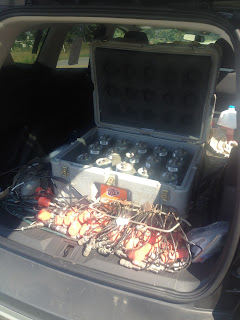roaming the hallways and the parking lot was full of SUV’s washed in clay, sand and
mud. When most of the second phase of the SUGAR project had come to a halt, there
was still work to be completed by the Seismic Source Team (SST). In order to
understand why, let me take you through the work schedule of the SST.
Dr. Harder and I drove to Atlanta on July 1st after completion of the ENAM
project in North Carolina and began scouting the shot-holes we would need to drill, load
and stem i.e. fill before the shot dates, which were scheduled for August 7th and 8th for
Line 2 and August 14th for Line 3. When scouting, you want to ensure that the shot-hole
locations selected have good, accessible roads and enough space for the drillers as well as
work crew to move in and out of easily. However beforehand, you want to ensure that
you have the permits to access different properties and have the correct keys for the
property entrance/exit gates, which Donna took care of. Scouting holes took 4 days
before drilling began on July 7th until July 29th.
 |
| An example of a good, accessible road for the drillers and SST to use. |
 |
| Pick a lock, any lock. One of the entrance/exit gates to a shot location. Thankfully, we had the key. I just had to test it on each lock to open the gate. |
am and leaving to work at 7:30/8 am. We would arrive on site about an hour later and the
drillers would set up and begin drilling. This would take about 2-3 hours at some holes
and 3-4 hours at others. The last hole composed of hard rock took about 14 hours to
complete. That does not include the time it took for us to stem the hole. We would
prepare the charges to load into the hole when the drillers had ~20 ft left to drill. They
drilled up to ~80 ft at the 2 shot-holes on the ends of Line 2 and ~70 ft for the remaining
13 shot-holes. For Line 3, they drilled all 11 holes to ~60 ft. After drilling and loading
the charges into the ground, Dr. Harder would lead the drillers to the next shot-hole while
Galen, Yogi and I would stay behind to stem the hole with gravel, sand and plug it with
bentonite. We would also check the detonators to make sure they worked before heading
off to the next shot-hole to repeat the process. On average, we would drive anywhere
from 100 – 200 miles per day depending on what we were doing and where we needed to
go.
 |
| Yogi (Victor Avila, left) and Galen preparing 2 charges to be lowered into the shot-hole. Each charge contains 2 detonators attached to 2 boosters indicated by the sets of wires. |
 |
| The drillers lowering the charge into the hole with Yogi carefully holding the detonator (orange wire) chords. On the left is the water truck and to the right is the drill rig. |
 |
| "The Beast" with a 1.1 Explosives placard after transporting the source materials to the shot location. |
 |
| Galen taking a GPS waypoint of the loaded shot-hole while Ashley tests the detonators to ensure that they are working. |
 |
| Dr. Harder (left) and Kent splicing the wires at one of the shot-holes to connect the detonators in order to shoot. |
where we met with Donna, Dan and everyone at the instruments center and began
preparing our equipment for the nights we were going to shoot. Shots would start at 11
pm and last until as late/early as sunrise depending on the weather conditions as well as if
the detonators would connect. The days that the deployment team members were
flagging and deploying instruments, we were busy driving to shot-holes and cleaning the
ones that blew out. The idea is that you make the shot-hole location look the way it did
before the shot took place.
 |
| Shot-hole 7 on Line 3. It looks like a regular hole, but it is actually about 5ft deep and has a 5ft diameter cavity. |
 |
| Using the backhoe to clean up the above shot-hole. |
 |
| After clean up!! |
remember Donna saying at our farewell dinner something along the lines, “We do all this
work for just a disk of data, but it’s all worth it.” She could not have summed it up any
better than that.
Here’s to another successful project….salud!
Ashley Nauer - UTEP































